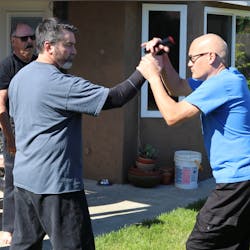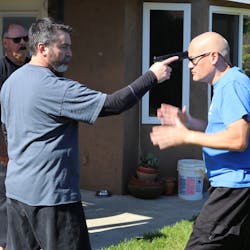Train To Take The Gun Away
While running some Tueller drills for this magazine’s December 2016 article, The 21 Foot Rule, and drills for The Distraction Strike, which appeared in the June 2015 issue, I began to look at some of the other problems with reaction time.
Law enforcement professionals need to know how to take away guns and knives.
Before we discuss this, I want to make some things perfectly clear. Deliberately putting oneself in a position where one has to take away a knife or a gun is just plain stupid. The best way to remove a weapon from a suspect is from behind cover, using a superior force in response to the aggressor’s actions, and good officer safety. When I train with police tactics in mind, everyone is potentially armed unless there is definitive proof that they are not. I don’t care if policy comes from someone whose experience is limited to watching videos on the internet; we train so officers return home after their shift.
If you are a reader who scours the internet for things to use against officers, know this—the guy who wrote this article actually made a living working a beat. We train because we know that the odds are stacked against us. Training has to be a matter of “what ifs” or “if this happens, what would you do” scenarios. Learning weapon takeaways is a matter of stocking more tools into the toolbox.
Back in police academy and in-service training, learning unarmed response was a box one had to check to move on to the next defensive tactics scenario. Each one of us must have said, “When would I ever face a gun or a knife without a gun?”
The truth is, at contact distance, it is sometimes quicker to jam the draw, or disarm, or both, than try to draw on someone with a knife or a gun. It is impossible to say at which moment that fighting is better than drawing, but, within the reach of the officer, the fastest weapons are the ones already in one’s hands.
There are some situations where the officer’s gun is better in the secure holster than drawing it a crucible distance. If the aggressor’s weapon is already out and the officer’s is in the holster, doing the unexpected but trained may be the way to get inside the observe, orient, decide and act (OODA) loop.
Rules and systems
There are some general rules for disarming. Since I firmly believe in simple techniques, I will keep it simple. If a person can shoot, get away, or get cover, use these measures over disarming. Otherwise:
- Get body parts out of the way of the path of the bullet or the sharp parts of the knife
- Take control of the weapon
- Incapacitate the aggressor
The “take control” part usually includes an incapacitating blow to the aggressor, applied simultaneously. When we move a weapon from one place to another, it is preferable not to move it across our centerline, an imaginary line drawn from our head to our feet that bisects us in relation to the opponent.
I have been around martial arts long enough to say that some techniques taught to the unsuspecting student simply don’t work. Some are designed by well-meaning individuals who don’t take into account the body mechanics involved. Some come from people who know little about the capabilities and effectiveness of a firearm or edged weapon.
Having said that, there are thousands of competent instructors that can train an officer to disarm and effectively incapacitate. As a rule, don’t look for techniques, look for systems. A system integrates techniques into an entire language that uses a single concept, the framework of a technique, and transcends it to a variety of situations.
For our Kensujitsu system (see the sidebar below), we use a basic wrist lock to disarm a knife, throw an opponent, or create a position of advantage in order to transition to another technique. Put simply, I have practiced the technique I would use to take a knife a thousand times, only because I use it for many other reasons.
I started training in Kensujitsu with Professor Joe Souza many years ago as a young rookie. I learned handcuffing techniques in academy that were only mildly effective. Professor Souza worked with me until I could lock up a person pretty well. I never became good at throwing or landing, but none of my fish ever got away. I learned (or, in actuality, am still learning) a system.
Gun takeaways
Our gun takeaways take bystanders into account. We use ASP Red Guns, and sometimes don Blauer Tactical Systems High Gear suits. We start the gun going in one direction, then use a strong mechanical advantage to twist the gun away. I have included a photo sequence for one of the techniques.It would not be prudent or responsible to give you a bunch of instructions, or even a bunch of photos. The way to do this is to work with the DTAC person at your agency and train with them often. If you are a law enforcement officer, you are already a martial artist. Arrive at a system, either by finding a viable system and instructor, and train often. The following is only an example for one scenario.
For the Gun at Forehead scenario, the officer grabs the gun, pushing the muzzle up. At the same time, the head goes down. Using the huge mechanical advantage of the length of the slide, the gun is twisted down and away.
If the finger was inside of the trigger guard during this motion, it is now broken. We are careful about this when using our Red Guns. The officer creates distance, and now points the gun at the aggressor.
There are a lot of potential gun pointing scenarios, which is why training is all about system. Many of them include controlling the gun and delivering a devastating strike simultaneously.
If we can disarm at the moment the gun is fully pointed at one of our body parts, we can practice disarming long before the muzzle settles. That is, once we recognize the threat, we can stop it in progress.
“What if”...
The gun could go off.
We know. When we use airsoft products (and protection), the gun occasionally will go off. I have experimented a little at the range, using proper handling and an abundance of safety practices. If someone shoots a standard semi automatic handgun and another person is holding the slide, using all other safe practices like muzzle discipline and a safe firing line, nothing happens. The bullet exits the barrel, travel of the slide to the rear is interrupted, the gun fails to extract, but nothing else happens. A person can hold onto a firing gun if no other alternative exists.
You’ll get cut.
When we are talking about defending against edged weapons, the likelihood of everyone involved getting cut is very high. It is important that officers understand that getting cut or stabbed does not mean the fight is over. Many people get cut and do not even realize they are cut. When it comes to knives, one can strip the knife away, lock the limb that has the knife (temporarily), deliver a blow that causes the person to drop the knife, or create space and time to allow the deployment of a firearm. Many knife responses are temporary, unless they strip and joint lock the assailant, which is what we train to do. Our techniques all remove the weapon and incapacitate the assailant.
These are perishable skills that require regular training. Train each day, a little at a time.
About the Author
A retired police officer and military small arms trainer, Lindsey Bertomen has taught shooting techniques for over a decade, in addition to teaching criminal justice at Hartnell College in Salinas, California. Off the clock he enjoys competing in shooting sports, running and cycle events. He welcomes comments at [email protected].
The creation of the Kensujitsu system
Professor Joe Souza, well known in the martial arts community, is the founder of the Kensujitsu system. Souza has been a martial artist since 1957. He has owned and operated several martial arts schools, too.
Souza was a practitioner of Kodenkan Danzan Ryu Jujitsu, where he currently holds a Kudan (9th degree). After many years of judo and jujitsu, Souza expanded his martial arts studies, earning his black belt in 1997 in the Ed Parker American Kenpo Karate system.
Studying Kenpo completed the circle to include a structured kicking, striking and blocking system. This was added to Kenpo and jujitsu. Souza had also seen the development of Small Circle Jujitsu. Using these disciplines, Professor Souza designed the Kensujitsu System. The foundation of Kensujitsu is Danzan Ryu Jujitsu, Kodokan Judo, American Kenpo Karate and a Small Circle Jujitsu influence.
Defend against a knife attack
The Hoffner Folding Knife is one of the most useful defensive knife designs on the market today. It has strategically placed textures, finger positioning divots for grip transitions, and deliberate grip enhancements that allow the user to use its full length.
The knife uses 440 steel and G10 scales. It has aggressive serrations on the top and bottom. The contours mate with the hand in a manner that sets it apart from other defensive tools, using a variety of grip positions.
When I met Brian Hoffner, a master police officer and law enforcement trainer at SHOT Show, he demonstrated that he designed his knives around a proven defensive system. His years of training officers to prevail in encounters went into the architecture of this tool.
The kit includes a training knife and a video. The training knife feels exactly like the live blade, including the rapid deployment. Just using it to practice carry and deployment from uniform wear makes this set worth every dime.
Consider adding Decal Grips
I like the texture of sandpaper on some of my guns, especially the ones with thin grips. Decal Grip products come in rubberized or sandpaper texture decals. The decals match the original texturing and contours of the gun. At first glance, the added grip decals don’t make the gun look any different, with or without. The added texture makes all the difference in the world.
Here’s why I like Decal Grips. The decals are die cut from sheets. Decal Grips send you the whole set, including the (discarded) material that outlines the decal panels. I save the discard material for my knives. I cut it to shape, adding grip for slippery conditions. Since Decal Grip products are inexpensive and the adhesive is tenacious, it is perfect for my edged tools.
About the Author

Officer Lindsey Bertomen (ret.), Contributing Editor
Lindsey Bertomen is a retired police officer and retired military small arms trainer. He teaches criminal justice at Hartnell College in Salinas, California, where serves as a POST administrator and firearms instructor. He also teaches civilian firearms classes, enjoys fly fishing, martial arts, and mountain biking. His articles have appeared in print and online for over two decades.

